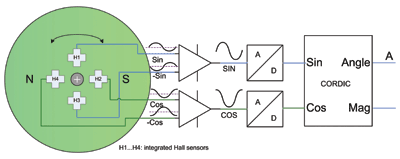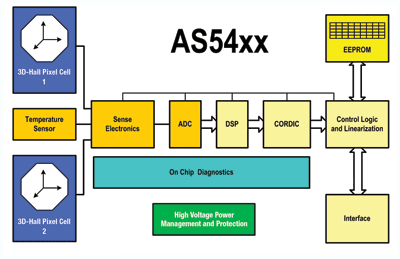What’s trending with Hall sensors?
Position-sensing applications benefit from advances in Hall sensor technology
BY MARCEL URBAN
austriamicrosystems AG
www.austriamicrosystems.com
Magnetic Hall sensors have been integrated into monolithic silicon devices for many years, and a number of different types of Hall sensors are available on the market today. They can be broadly classified into four groups:
• Standard absolute sensors and switches
• Hall encoders
• Hall encoder+ magnetic field concentrator
• 3D Hall encoder
The evolution of Hall sensor-based ICs has seen a transition first from one-dimension (1D), discrete Hall sensors to highly integrated Hall encoders that contain arrays of Hall sensors on a single die. This step was itself revolutionary and enabled many more position-sensing applications to be served by the accurate, precise and robust technology of Hall encoders.
The latest shift is to three-dimension (3D) arrays of Hall sensors and expands yet further the number of applications that can benefit from magnetic position sensing. This article puts the development of 3D Hall sensing in its historical context, and illustrates through a practical example the precision and accuracy of this latest evolution of the technology.
1D Hall sensing
The standard absolute Hall sensor has dominated the Hall sensor market since the 1980s. This type of sensor measures the magnetic field in one direction. The output signal is amplified, offset and adjusted by programming. While this sensor is simple, reliable and well understood, the applications that it can serve are restricted by its one-dimension topology. It is typically used today in position end-point switches, and can be tailored to specific applications such as cam and crankshaft sensors in car engines. This type of sensor is available in various small package types.
The beginning of the new millennium saw a more advanced Hall sensor type appear on the market: the magnetic Hall encoder. This type of sensor integrates multiple 1D Hall sensors on one die, as well as signal processing and digital computation functions (see Fig. 1 ). This multiple-1D sensor topology enabled the implementation of magnetic rotary and linear position sensors.

Fig. 1: Multiple 1D Hall sensors in an array around the center point.
As usual, integration delivers benefits such as miniaturization and cost-effective mass production, and has driven the widespread replacement of older optical encoder technology. The encoder designed by austriamicrosystems uses a differential measurement principal, resulting in very high immunity to stray magnetic fields, as well as temperature and other environmental effects.
All types of Hall encoders provide huge advantages over discrete Hall sensors and are used in hundreds of rotary, linear and off-axis position measurement systems. Indeed, manufacturers such as austriamicrosystems have developed families of encoders optimized for different applications, such as linear sensing, on-axis rotary sensing, off-axis rotary sensing and BLDC (brushless dc) motor control.
But the drawback of the multiple-1D sensor topology is that if the specifications for the application change, often the encoder IC must change too, entailing redesign time and effort. This is a problem addressed by the latest generation 3D Hall encoders.
Enter 3D Hall sensing
The first IC with 3D Hall sensing technology was announced in 2006 by Fraunhofer IIS in Erlangen, Germany. austriamicrosystems licensed the technology and created the AS54xx IC family which includes two or more 3D pixels on one die, enabling differential outputs. Just as with 1D magnetic encoders, the new AS54xx encoders achieve highly precise measurement capability and indifference to environmental effects. Most importantly, the ability to sense magnetic fields in three dimensions transforms the capability of the IC and allows different trigonometric calculations by one device
Figure 2 shows the basic block diagram of the 3D Hall Encoder. Two 3D pixel cells measure the magnetic field components; the pitch distance between the pixels is 2.5 or 5 mm. In each cycle, all six signal components (3 magnetic field components in each pixel cell) plus temperature information are sent to the DSP and arctangent (ATAN) coordinate computer. An integral linearization function is used in some position measurement applications.

Fig. 2: Block diagram of a 3D Hall encoder, the AS54xx.
The example below is for linear position measurement over a wide mechanical stroke of 40 mm – a much longer distance than is possible with first-generation (1D) magnetic encoders. A standard SmCo (samarium–cobalt) magnet is the magnetic input source, although any magnetic material could be used.
The following input parameters were chosen:
Magnet type:axial magnetized in x direction (square magnet SmCo)
Magnetization: B = 0.94 T
Dimensions (x, y, z): 3 mm, 6 mm, 6 mm
Pixel Pitch: 2.5 mm
Travel distance of the magnet: ±20 mm
Air gap, IC to magnet: 3 mm
A simple ATAN calculation is used to convert the magnetic field data into linear position data (in millimeters). A linearization table is needed as the waveforms are not exact sine waves.
In a first-generation encoder, position coordinates would be derived from one-dimensional magnetic field data; here, coordinates are derived from data about magnetic field strength in two dimensions. Combining the two sets of position data produces far higher sensitivity, which in turn supports a longer measurement range combined with high accuracy.
The resulting output error is below ±1% over the measurement range in both gradient and absolute mode. This value would be even better if the size of the magnet were increased. This very high accuracy, even in the presence of a small magnetic input field, delivers a reduction in magnetic material costs by a factor of as much as four when compared to encoders based on the multiple 1D sensor with field concentrator topology. With the rising cost of rare earth magnets, this feature becomes very attractive. Conversely, since rare earth magnets are three times stronger for a given size, high sensitivity allows a much smaller rare earth magnet to be used where size is critical.
The technology also provides a great deal of mechanical tolerance. For instance, large air gaps between the sensor IC and the magnet will not affect measurement results. Likewise, the device will be indifferent to a shift over time in the air gap.
Implementing 3D Hall technology in end products
The combination of integrated 3D Hall sensor technology with signal conditioning and digital processing, together with high-voltage capabilities up to 27 V, enables new automotive applications. These sensors are also well suited for industrial applications, where they can run from a 3-V supply and hook up to a standard SPI interface, and provide reliable and robust performance in dirty and hostile environments. The devices can provide not only position data but also temperature information and the individual magnetic signal components, which can be used for off-chip calculation with specialized algorithms. ■
For more information, visit www.austriamicrosystems.com/eng/Products/Magnetic-Encoders/3D-Hall-Encoders
Advertisement
Learn more about ams (formerly austriamicrosystems)





